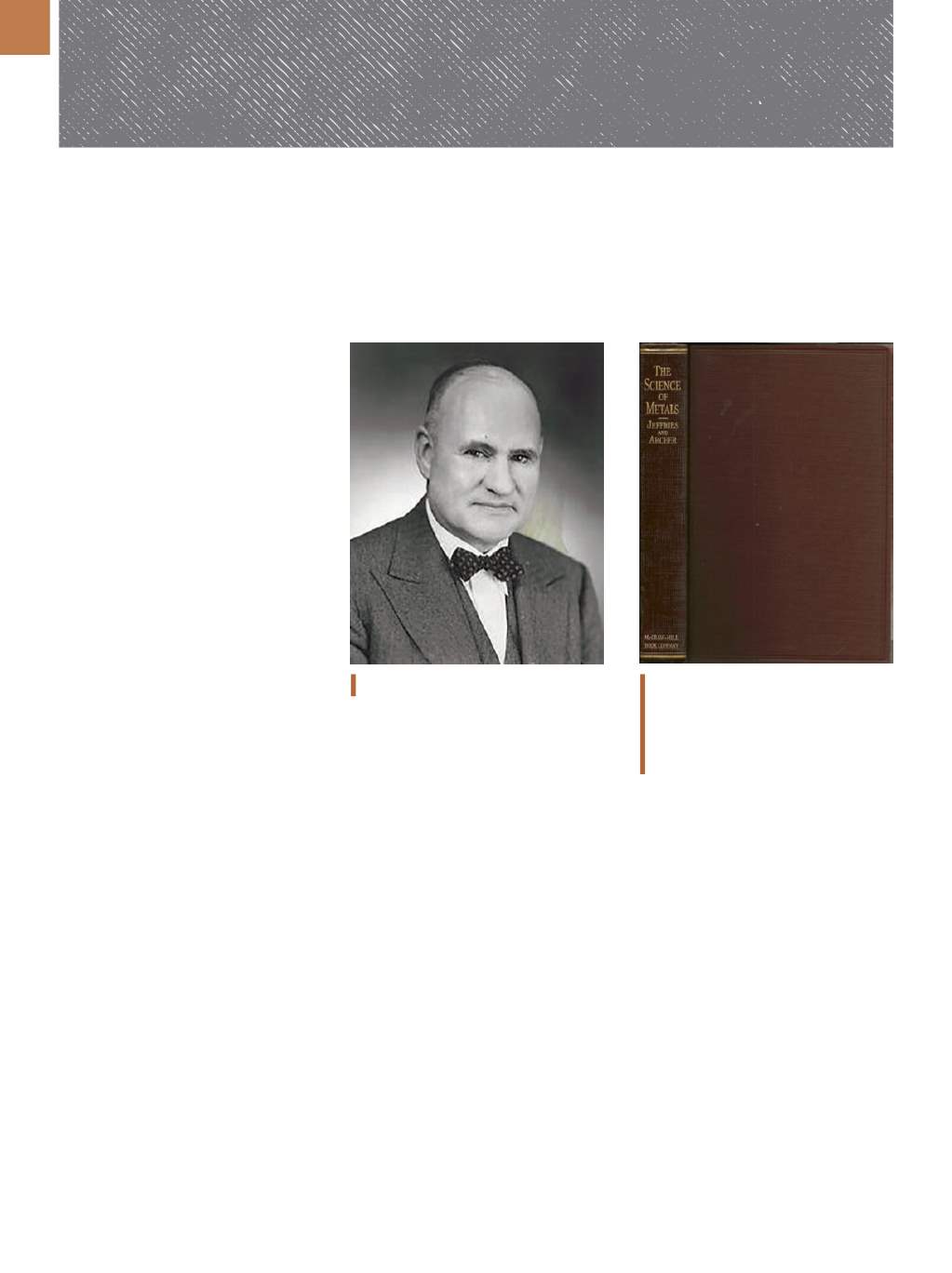

A D V A N C E D M A T E R I A L S & P R O C E S S E S | O C T O B E R 2 0 1 5
3 6
METALLURGY LANE
Metallurgy Lane, authored by ASM life member Charles R. Simcoe, is a continuing series dedicated to the early history of the U.S.
metals and materials industries along with key milestones and developments.
PIONEERS IN METALS RESEARCH—PART II
AMONG HIS PEERS, ZAY JEFFRIES WAS CONSIDERED THE ELDER STATESMAN OF AMERICAN METALLURGY.
T
he first generation of metallur-
gists to teach the new field of
metallography includes Henry
Marion Howe of Columbia’s School of
Mines, Albert Sauveur of Harvard, and
C.H. Mathewson of Yale. Their students
would go on to advance the knowledge of
metallurgy as we know it today. The first
of these graduates was Isaiah (Zay) Jef-
fries, who studied mining engineering at
the South Dakota School of Mines. After a
brief time working in themining industry,
Jeffries spent his career working inmetal-
lurgy. He became the most widely known
metallurgist in America during the 1920s
for his work on tungsten for lamp bulbs,
research into grain size and its influence
on mechanical properties, the many alu-
minum alloys he helped invent, and the
behavior of high-speed steel during sec-
ondary hardening. He also trained many
young metallurgists who worked with
himat his laboratories in Cleveland.
Jeffries was born in the Dakota
Territory in 1888, one year before it
became the state of South Dakota. His
parents, Johnson and Florence Jeffries,
had moved west from Illinois for ranch-
ing and farming opportunities. Zay
grew up in Fort Pierre, a small commu-
nity on the Missouri River. As a teenager
he helped on the farm, which consisted
mainly of capturing wild horses and
breaking them for riding. He attended
high school in Pierre, a larger commu-
nity across the Missouri River, where he
discovered an interest in geology, which
he hoped to pursue in college.
Jeffries enrolled in 1906 at the new
South Dakota School of Mines in Rapid
City. However, he found limited edu-
cational opportunities in geology and
soon transferred to mining engineering.
He received some metallurgical and
metallographic training from the univer-
sity’s president and professor, Charles
Fulton, who had studied under Howe at
Columbia University. Jeffries graduated
in 1910 in a class of 10 out of a total en-
rollment of 44 students. After working
in the mining industry for one year, Jef-
fries received an invitation from Fulton,
who was then a professor of metallurgy
at the Case School of Applied Science
in Cleveland, to join him as an instruc-
tor of metallurgy and metallography.
He immediately accepted the offer and
moved to Cleveland in 1911. For the
next two years, Jeffries devoted all of his
time to teaching and learning the avail-
able knowledge in metallurgy and me-
tallography. By 1914, he was prepared
for consulting assignments.
CONSULTING WORK
Jeffries’ first major consulting as-
signment was with the General Electric
Lamp Division, which was transitioning
to tungsten filaments for light bulbs. He
Zay Jeffries.
successfully solved several problems in-
volving microstructure, especially with
regard to grain size. This was ground-
breaking science before x-ray diffrac-
tion showed that grains were crystalline
with different orientations in space. Jef-
fries’ most influential work was his re-
search on grains and grain size and their
impact on the mechanical properties of
metals. Of special interest at the time
was what held grains together, that is,
what filled the space between grains
where different orientations meet.
A theory advanced at the time was
that this space was filled with
amor-
phous metal
—metal without crystal
structure. This amorphous metal acted
as a cement that held grains togeth-
er during plastic strain, such as hot
and cold working. Elongation of grains
during cold working was believed to
Zay Jeffries and Robert Archer worked
together throughout the 1920s to de-
velop aluminum alloys for castings and
forgings, and coauthored
The Science of
Metals
in 1924.


















